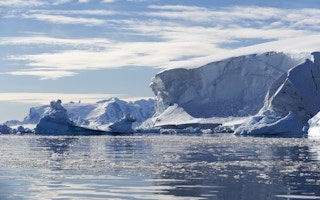Antarctic glaciers once thought relatively stable are starting to melt. Evidence from a five-year satellite study of the frozen rivers on the southern Antarctic Peninsula now reveal that these are shedding ice at the rate of 60 cubic kilometres a year: altogether around 300 trillion litres of water has moved from the frozen continent to the oceans.
Bert Wouters of the University of Bristol, UK, and colleagues report in the journal Science that they used data from two very different research satellites to confirm their findings.
The European Space Agency’s CryoSat-2 has been orbiting the polar world since April 2010, bouncing radar signals off the surface and measuring the return travel time. An examination of five years of results shows that the glacial surfaces are sinking, in some places by as much as four metres a year. There could be two reasons for that: either the snow is compacting or the ice is flowing faster.
But results from the US space agency Nasa’s GRACE mission – the acronym stands for Gravity Recovery and Climate Experiment – settle the matter. The mass of ice lost in the region is so large that it changes the local gravity field, and the changes in the sheer weight of 750 kilometres of glaciers in the region can be measured from space.
“
To date, the glaciers added roughly 300 cubic km of water to the ocean. That’s the equivalent of the volume of nearly 350,000 Empire State Buildings combined.
Dr Bert Wouters, University of Bristol
“To date, the glaciers added roughly 300 cubic km of water to the ocean. That’s the equivalent of the volume of nearly 350,000 Empire State Buildings combined,” Dr Wouters said.
“The fact that so many glaciers in such a large region suddenly started to lose ice came as a surprise to us. It shows a very fast response of the ice sheet: in just a few years the dynamic regime completely shifted.”
Melting maintained
That the southern continent is responding to climate change of some kind is not in doubt:another study has put the overall mass loss at 92 billion tons a year, and twin assaults of warmer air above, and warmer waters around the continent, continue the attrition.
What is not yet certain is whether scientists are looking at the consequences of human-made global warming or at the see-saw conditions inherent in some kind of as-yet-unidentified natural cycle.
But ice loss on that scale cannot be easily explained by changes in snowfall or air temperatures, so suspicion falls on the effect of warmer waters. The glaciers flow into seas that are surrounded by ice shelves. The ice shelves have lost one fifth of their thickness in recent decades, so they offer less resistance to the land-based ice, allowing the glaciers to accelerate.
There is a second factor: some of the glaciers are grounded on continental bedrock that is depressed below sea level, which means that warmer ocean waters can penetrate further inland and melt the glaciers from below.
Cautious response
There are questions that have yet to be resolved. As usual in science, the interpretations are open to debate. “Although these latest CryoSat measurements of Antarctic thinning agree with findings from two studies reported last year, I think the new estimates of ice loss computed from them are far too high, because the glaciers in this sector just haven’t speeded up that much,” said Andy Shepherd, professor of earth observation at the University of Leeds in the UK and principal scientific advisor to the CryoSat mission.
“It could be that a bigger chunk of the thinning is down to snowfall fluctuations than the authors have accounted for, and so I would be cautious about the new numbers until more information is to hand.”
Dr Wouters agrees that more research is necessary. “It appears that some time around 2009, the ice shelf thinning and the subsurface melting of the glaciers passed a critical threshold which triggered the sudden ice loss. However, compared to other regions in Antarctica, the Southern Peninsula is rather understudied, exactly because it did not show any changes in the past, ironically,” he said.
“To pinpoint the cause of the changes, more data need to be collected. A detailed knowledge of the geometry of the local ice shelves, the ocean floor topography, ice sheet thickness and glacier flow speeds are crucial to tell how much longer the thinning will continue.”










